Ever dismissed product descriptions as unimportant? Assumed that as long as the information on your product page is accurate, you’re good to go? It’s time to think again.
Product descriptions are more than a summary of what you’re selling. Written correctly, they can boost your store’s conversion rate and make your products seem more valuable. The right words can even make customers happy to pay more.
Here’s how to make product descriptions work harder for your ecommerce business.
Let Shopify Magic write product descriptions for you
Ever wished a product description would write itself? With Shopify Magic—Shopify’s artificial intelligence tools designed for commerce—it will. Create product descriptions in seconds and get your products in front of shoppers faster than ever.
Learn about Shopify Magic
What is a product description?
A product description is a piece of marketing copywriting that tells people what a product is and why it’s worth buying. Beyond a list of product details or features, descriptions tell a story about what makes a product special and persuade customers to make a purchase.
Product descriptions can vary in length, style, and format, and may be written in a brand’s unique voice.
What makes a good product description?
A well-crafted product description can significantly impact sales, customer satisfaction, and brand reputation by performing a dual purpose:
- It informs customers about product details, such as its features, uses, and benefits. This helps customers understand what the product is and how it works.
- It convinces customers of the product’s value. This is where the persuasive power of a product description comes into play. It answers questions like, “What problem does a product solve?” and “What makes it better than the competition?”
By addressing these points, a good product description paints a clear picture of a product’s value proposition. It highlights the unique benefits and advantages that set a product apart from its competitors.
Good product descriptions move buyers through a sales funnel, turning them from interested browsers to motivated buyers, making them more likely to hit the Buy button.
How to write compelling product descriptions that sell
Many online stores list the features of their products and call it a day. While clear information about your items is important, you also need to tell people how a product can help them.
Let’s look at how you can create descriptions that capture your product’s value:
- Speak to your ideal customer
- Highlight benefits, not features
- Avoid generic phrases
- Support superlatives with facts
- Feed customers’ imagination
- Tell your product’s story
- Use sensory language
- Add social proof
- Make descriptions scannable
- Set and measure KPIs
1. Speak to your ideal customer
When product descriptions are written with a broad audience in mind, they can become vague and fail to resonate.
To make your descriptions engaging, speak directly and personally to your target audience. Anticipate and answer product-related questions as if you were having a one-on-one conversation, using language and terminology that resonates with your ideal customer. That includes using the word “you.”
Take a look at how The Oodie, an apparel retailer, harnesses this approach in the product description for its I Love Plants Oodie.
I Love Plants Oodie product description:
“Can’t stop buying plants? Unbeleafable. Don’t worry—us too! Cover yourself in your favourite obsession in our NEW I Love Plants Oodie! For every I Love Plants Oodie sold, one tree is planted across the world.”
When writing product descriptions for your ecommerce business, start by visualizing your ideal customer. What kind of tone do they appreciate? What vocabulary are they familiar with? Are there certain words they dislike? What questions might they have?
Think about how you would communicate with your ideal customer if you were selling your product face-to-face in a physical store. Then, try to incorporate that language into your ecommerce site. This approach can help create an online conversation that resonates more deeply with your customers, making them feel understood.
2. Highlight benefits, not features
While it’s natural to be excited about the unique features of your products, potential buyers are more interested in how these features will benefit them. They want to understand how your product will solve their problems or enhance their lives.
Writing an effective product description, therefore, requires highlighting the benefits of each feature—addressing any uncertainty or cognitive bias around the helpfulness of your product. A good example of this approach comes from Dr. Squatch, a company that sells natural soaps for men.
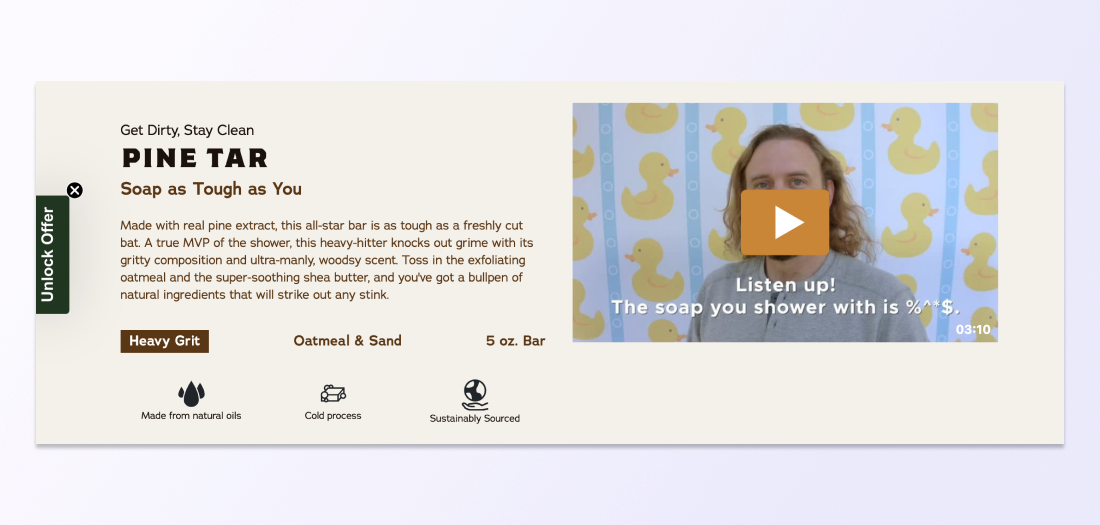
Pine Tar soap product description:
“Made with real pine extract, this all-star bar is as tough as a freshly cut bat. A true MVP of the shower, this heavy-hitter knocks out grime with its gritty composition and ultra-manly, woodsy scent. Toss in the exfoliating oatmeal and the super-soothing shea butter, and you’ve got a bullpen of natural ingredients that will strike out any stink.”
Dr. Squatch’s product page places the ingredients list of its Pine Tar soap on a hidden tab, choosing instead to lead with a description, which paints a vivid picture of the experience of using the product.
The description suggests that the soap performs its function (to clean) in a way that’s specifically suited to its target customer (men looking for a natural yet heavy-duty bathroom product).
When writing product descriptions, consider the benefits of each product feature. How can your product make your customers’ lives better, easier, or more enjoyable? What problems does your product solve? Remember, you’re not selling a product; you’re selling an experience.
Dr. Squatch’s description also uses a brand-relevant extended metaphor (baseball) and overtly masculine adjectives (“tough,” “woodsy,” and “gritty”) to appeal to its target audience. Fine-tuning your copywriting in this way can help your product resonate.
3. Avoid generic phrases
When you’re unsure what to say about a product, writing descriptions can get challenging. It’s tempting to resort to general, overused phrases such as “effective” or “high quality.” However, clichés fail to impress potential buyers. They’ve heard these claims before, and they don’t provide unique or persuasive information about your product.
To avoid banalities, be as specific as possible in your copywriting.
Take Beardbrand, for example. Instead of making broad claims about the effectiveness of its products, it provides detailed reasons why its Best Sellers Bundle is so popular.
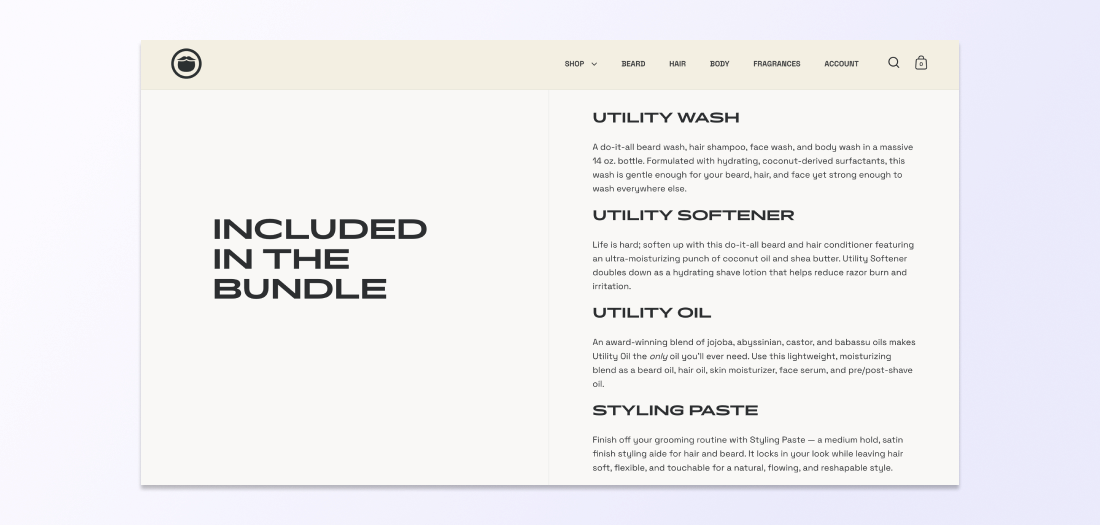
Beardbrand Best Sellers Bundle product description:
“A do-it-all beard wash, hair shampoo, face wash, and body wash in a massive 14 oz. bottle. Formulated with hydrating, coconut-derived surfactants, this wash is gentle enough for your beard, hair, and face yet strong enough to wash everywhere else.
“Life is hard; soften up with this do-it-all beard and hair conditioner featuring an ultra-moisturizing punch of coconut oil and shea butter. Utility Softener doubles down as a hydrating shave lotion that helps reduce razor burn and irritation.
“An award-winning blend of jojoba, abyssinian, castor, and babassu oils makes Utility Oil the only oil you’ll ever need. Use this lightweight, moisturizing blend as a beard oil, hair oil, skin moisturizer, face serum, and pre/post-shave oil.
“Finish off your grooming routine with Styling Paste — a medium hold, satin finish styling aide for hair and beard. It locks in your look while leaving hair soft, flexible, and touchable for a natural, flowing, and reshapable style.”
Detailed descriptions like these serve multiple purposes. First, they add credibility to your products. By explaining the specific benefits of each product, you show potential customers that you know your products well and believe in their value.
Second, detailed descriptions help customers visualize how they’ll use the products. By painting a clear picture of the product experience, you help customers understand exactly what they’re buying and why it’s worth their investment.
Lastly, detailed product descriptions build trust. When you can speak with authority about the granular details of your products, customers are more likely to trust your brand.
💡 Once a product description has enticed a customer, Beardbrand uses a subscription model to generate recurring revenue from them.
4. Support superlatives with facts
Superlatives can sound insincere in product descriptions—unless they are substantiated with clear evidence. If you claim your product is the best, the easiest, or the most advanced, you need to provide specific reasons why.
An example of this product-writing technique can be seen in the product description for Casper’s Wave Hybrid Snow mattress.
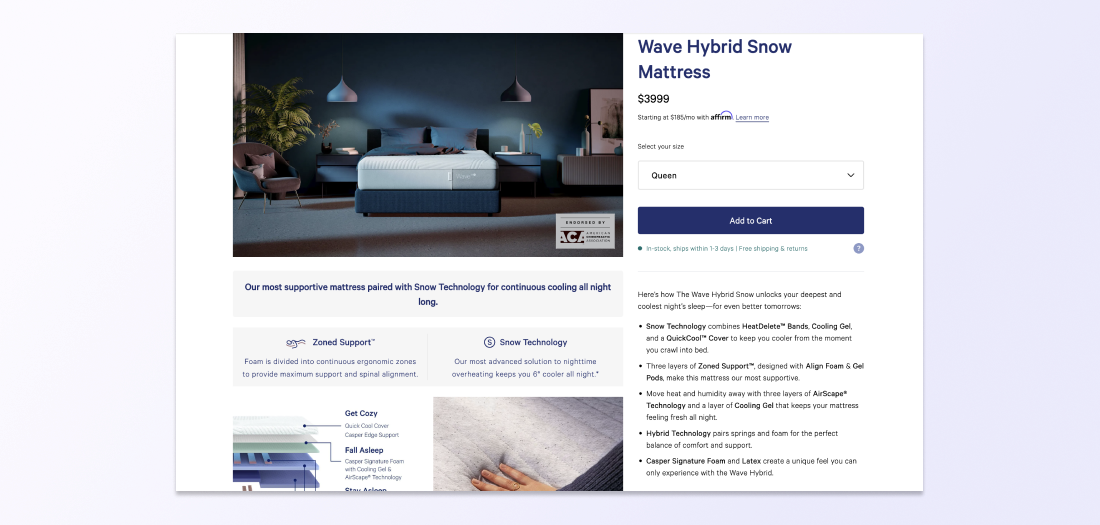
Casper Wave Hybrid Snow mattress product description:
“Our most supportive mattress paired with Snow Technology for continuous cooling all night long. Here’s how The Wave Hybrid Snow unlocks your deepest and coolest night’s sleep—for even better tomorrows:
“Foam is divided into continuous ergonomic zones to provide maximum support and spinal alignment. Our most advanced solution to nighttime overheating keeps you 6° cooler all night.”
While Casper makes the bold claim that its product can unlock your deepest night’s sleep, it backs up the rhetoric with factual evidence. The product description explains how “Casper Labs testing” has verified mattress performance. Additionally, Casper offers a 100-day free trial period to show confidence in its product and allow customers to verify the claim for themselves.
If your product really is the best in its category, provide specific proof. Otherwise, tone down your product copy—or quote a customer who can provide a positive subjective opinion.
5. Feed customers’ imagination
Research proves that physically touching a product in a store can create feelings of ownership and increase the likelihood of a purchase.
So, how can you recreate that effect online, when your customers can’t physically interact with your products? High-quality product photography and videos can help—but there’s also a powerful ecommerce copywriting technique to increase desire: let your reader imagine what it would be like to own your product.
Notice how Todd Snyder applies aspirational content, in the form of a tagline and hero image, to promote its Spring clothing collection.

Clothing collection tagline:
“Dreaming of the Amalfi.”
Todd Snyder transports website visitors to the Amalfi Coast in Italy, a place associated with luxury, chill vibes, and classic style. The image helps link Todd Snyder’s clothing collection to the dreamy lifestyle you’d find in this famous Italian spot.
To practice this copywriting technique, start a paragraph with the word “Imagine” and finish it by explaining how your readers will feel when they own your product. Then, use what you’ve generated to write an aspirational tagline in your brand’s voice.
Let’s say you’re selling an espresso machine called the Barista Pro. First, you might create this imagined scenario:
Imagine stepping into your kitchen, the sun peeking through the windows. You pull a perfect cup of coffee from your Barista Pro and experience the rich aroma of a freshly brewed latte. You feel satisfied and energized.
From that scenario, you can craft a product tagline:
Start each day with an extra shot of joy.
6. Tell your product’s story
One effective way to create engaging product descriptions is to tell the story of your product. A well-crafted narrative can make your product more relatable and memorable, helping it stand out in a crowded marketplace.
A product’s story can include the inspiration behind its creation, the challenges faced during its development, or the impact it has had on customers since launch.
When crafting a product story, consider the following:
- What inspired the creation of the product?
- What challenges were faced during development?
- How does the product reflect your brand’s values or mission?
- What impact has the product had on customers’ lives?
7. Use sensory language
Sensory language refers to words that describe how we experience the world: how things taste, smell, look, feel, and sound. By using sensory words in your product descriptions, you can help customers imagine what it’s like to own your product.
When you use sensory language in your product descriptions, you’re not just making your products sound more appealing—you’re also engaging more of your customers’ brains. A recent study has shown that social media influencer posts can generate higher engagement when they contain sensory words like “crumble” and “juicy.”
Another study revealed that exposure to tactile verbs (e.g., “touch”) can prime your brain to react as if you’re actually touching an object.
When writing your own product descriptions, think about how your product engages the senses. Whether it’s the “crisp” sound of a new keyboard, the “smooth” feel of a luxury fabric, or the “bright” flavor of a fresh fruit, sensory language can make your product descriptions more engaging.
8. Add social proof
When potential customers are unsure about buying a product, they often look for advice from trusted sources. While you can provide reassurance through high-quality product descriptions and other on-page tactics, you can’t be a neutral third-party.
This is where customer reviews and industry testimonials come in. Social proof is the idea that people are influenced by others’ actions or opinions. Examples of social proof include a comments section, customer reviews, quotes from professional critics and review sites, or mentions from mainstream newspapers and industry magazines.
Athletic wear brand Gymshark includes detailed customer reviews on each product page. They go beyond a traditional star rating system by including six relevant and easily understandable review criteria, such as “comfort” and “squat proof.”
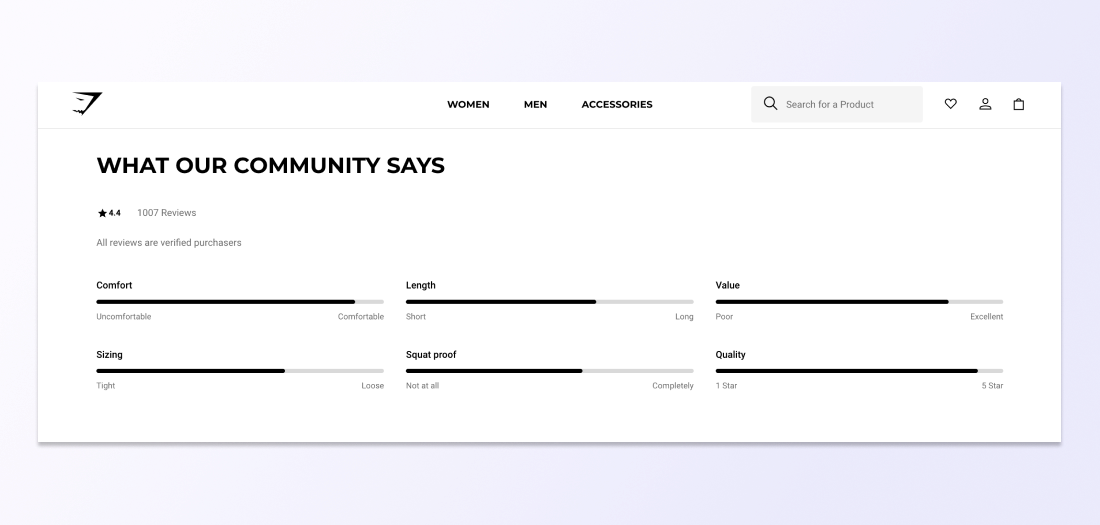
Asking customers to review specific product features is a simple, effective way to show that you understand what your customers care about.
If you don’t have enough customers to host an active review section, consider allocating some of your marketing budget to sponsored content about your product in a relevant, well-known publication.
At the very least, you can include images of people using your products to create the impression that your product is popular and trusted. Seeing others use and enjoy a product can reassure potential customers that they’re making a good choice.
9. Make descriptions scannable
Does your website design encourage visitors to read your product descriptions?
Consider how Kettle & Fire presents its product information. The brand uses eye-catching icons, simple dropdown tabs, and bullet points to make the content easy to scan.
Visitors can quickly scroll through the page and understand pricing, key benefits, ingredients, usage recommendations, customer reviews, and the brand’s values, all within a few seconds.
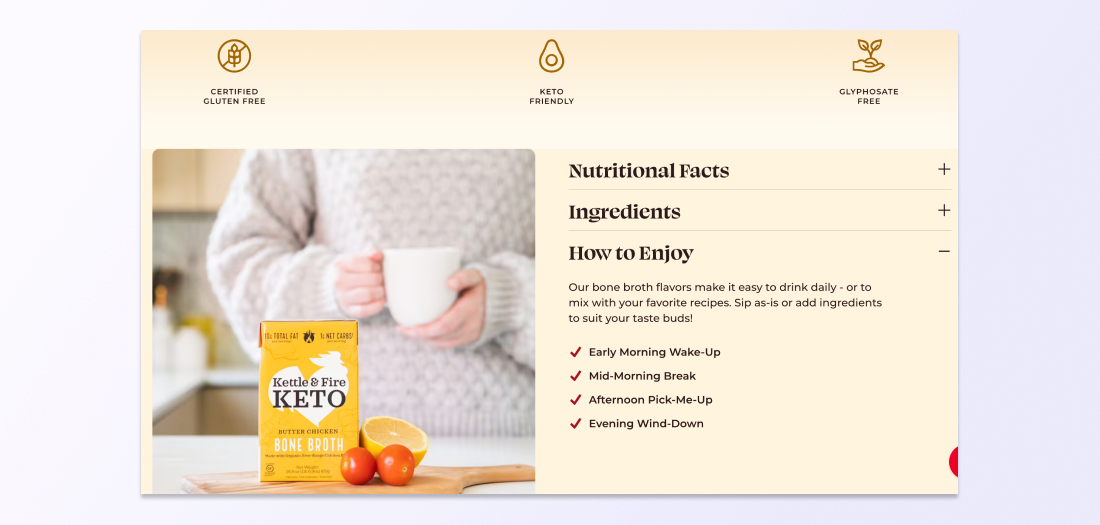
Kettle & Fire also organizes information based on what customers care about most. Different categories of information are separated by contrasting background colors, providing an instant visual guide.
Keeping your product descriptions clear and easy to scan makes them more reader-friendly and appealing to potential customers.
Here are some visual ideas to make your descriptions more scannable:
- Use headlines: Grab your visitor’s attention with compelling headlines.
- Use bullet points: Break up information into easy-to-read bullet points.
- Use white space: Don’t be afraid of white space. It can make your content easier to digest.
- Use a readable font size: Using a bigger font size can improve readability.
- Use high-quality product images: Well-designed and placed images can convey a lot of information quickly.
10. Set and measure KPIs
The aim of a product description is to convince a shopper to buy. But how can you tell if your descriptions are doing their job?
Here are some common key performance indicators to monitor on your product pages. They can indicate whether your product descriptions are working:
- Conversion rate tells you how many page visitors you converted into leads or customers.
- Cart abandonment rate shows how many shoppers put an item in their cart but left without buying. All stores deal with cart abandonment, but if this KPI is poor, your product descriptions and checkout process may need some work.
- Return rate highlights how many products are being returned. If it’s high, it could mean that your product descriptions or images aren’t accurately representing your products.
- Support inquiries. If you’re getting lots of questions about a product through email or a live chat feature, it could mean that the product description isn’t clear.
- Organic search engine rankings directly correlate with the amount of traffic entering your website. Good product descriptions help with search engine optimization and make your products show up in search results, leading to more visitors and sales.
Once you’ve picked which KPIs you want to watch, consider running some tests to see if you can optimize your product descriptions. A popular type of test used to iterate descriptions is A/B testing. This involves making a new version of your product description and serving it to a subset of your audience, allowing you to compare the performance of each version in real time.
You can run multiple A/B tests to fine-tune your product descriptions, until they are fully optimized for your KPIs. Try an app like OptiMonk to run tests on your Shopify store.
Product description template
Even if you’re using AI to write great product descriptions, you need to consider the features and benefits of each product individually. Every product serves different needs, and every set of potential customers has distinct buying triggers.
That said, it’s possible to take a similar approach to writing product descriptions across your store, by developing a product description template containing open-ended prompts.
Try developing a template with two sections: a brainstorming section followed by a draft description section.
Product description brainstorm
Answer these questions for each of your products to develop unique, relevant information that you can craft in to a product description:
- Who’s the ideal customer for this product? Knowing who your product is for is foundational to writing a good description.
- What are the products’ basic features? Collect dimensions, materials, functions, care instructions, and other factual details about the item.
- When should the product be used? List the intended use cases for your product. Highlight the ideal scenarios for when a customer should use your product.
- What makes the product special? Think about the unique benefits of your product and why it’s better than similar offerings from competitors.
Product description draft
Once you’ve collected your product information in a document, use the following template to draft your product description.
- Write an attention-grabbing product title: Keep your copy short and simple while communicating a product use or benefit. For example, if you’re selling a patterned yoga t-shirt, you could call it the Fleck Studio Shirt.
- Craft a short paragraph: Turn your product information into an entertaining description that tells a clear story. For example, you could describe a scene in which your product is being used.
- Create a bulleted list: Add a section that lays out product features and materials.
- Include social proof: Deploy a product review app to capture customer reviews on your product page and integrate any customer feedback that already exists on search engines or social media platforms.
Get your free ecommerce copywriting template
Want to write compelling copy that convinces your website visitors to click, sign up, or buy? Master high-conversion copywriting and increase your sales with our easy-to-follow framework.
Learn More
Product descriptions are always worth the effort
Writing product descriptions for your online store isn’t about listing features. It’s a chance to connect with your target customers and show them exactly how a product fits into their lives.
Taking time to share your enthusiasm about a product’s backstory, design process, and thoughtful details proves you’re excited about your store’s items—making it more likely your customers will get excited, too.
Product description FAQ
How do you write a product description statement?
To write an effective product description, follow these steps:
- Know your audience: Understand who your ideal customer is and what they care about. Use language and terminology that resonates with them.
- Highlight benefits, not features: Explain how your product can solve a problem or enhance the customer’s life.
- Use sensory language: Describe how the product feels, smells, sounds, tastes, or looks to help customers imagine owning or using it.
- Tell a story: Share the inspiration behind the product or its impact on customers to make it more relatable and memorable.
- Avoid clichés: Be specific and avoid overused phrases.
- Include social proof: Add customer reviews or testimonials to build trust and credibility.
- Make it scannable: Use bullet points, subheadings, and white space to make the description easy to read.
- Include a call to action: Encourage customers to make a purchase or take the next step.
What is the purpose of a product description?
Product descriptions have two purposes: to inform and persuade potential customers. Product descriptions inform readers by detailing a product’s features, helping them understand use-cases and value. Simultaneously, they persuade readers by showcasing a product’s benefits and solutions, compelling them to purchase.
What needs to be in a product description?
A product description should clearly highlight the key features and benefits of your product to attract customers. You should make it engaging by using persuasive language that speaks directly to their needs and desires.
What is a good product description format?
A good product description starts with an attention-grabbing product title, followed by a brief paragraph telling a story about a product’s value. Next, include a bulleted list of product features and details for easy scanning. Add customer reviews for credibility, and finish with a compelling call to action.




